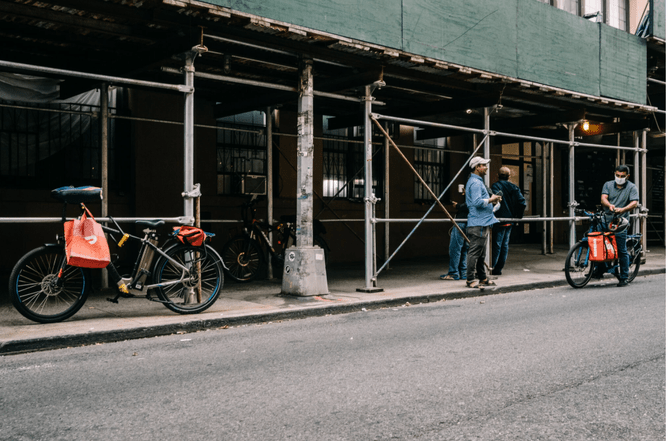N.Y.C.’s Bike Parking Problem: 1.6 Million Riders and Just 56,000 Spots
Not such a bad problem to have!! If NYC can have such a successful uptake in cyclists, there's no reason that small towns in NZ can't.
----------------------------------------------------------------
Article: NY Times, By Winnie Hu
During the pandemic, bicycling boomed, leaving many cyclists to lock and park their bikes wherever they can.
The pandemic set off an extraordinary surge in biking in New York City as people sought to avoid public transit and embrace new ways to exercise.
But now the spike has run headlong into a familiar problem on the city’s congested streets: no parking. Cyclists have rolled up to apartment buildings, offices, stores and restaurants only to find nowhere to leave their bikes. Many lug them inside, or improvise makeshift parking by locking them to street signs — breaking a city law that is rarely enforced — or trees, gates and fences.
The lack of parking, cyclists and advocates complain, has even helped fuel a jump in bike thefts.
Tasha Rose said she gets stressed trying to find a safe place to park her bike while riding around Brooklyn and Queens picking up food donations from local residents and groups to stock free community refrigerators. She had two bikes stolen last year after locking them to fences.
“I’m like, ‘I’ve got to go, I’ve got to get back to my bike,’” said Ms. Rose, 35, a freelance tour manager and merchandise vendor for musicians who is out of work and has also used her bike to get to temporary gigs walking dogs. “Since my bike is my No. 1 go-to for transportation, obviously keeping it safe and secure is my main priority when I’m out and about.”
Even as New York has created the largest urban bike network in the nation with 1,375 miles of bike lanes and a thriving bike-share program, Citi Bike, it has lagged well behind other cities in making bike parking spots widely available, transportation experts and advocates say.
New York has roughly 56,000 bike parking spots on its streets, sidewalks and plazas. Most are part of bike racks, though there are 83 corrals — car parking spots converted to hold bikes — and 20 shelters that shield bikes from snow and rain. (The 56,000 does not include Citi Bike, which has 38,000 spaces in about 1,100 docking stations.)
By comparison, London has three times as much bike parking, with more than 150,000 cycling spaces on its streets and an additional 20,000-plus spaces at Underground and rail stations. There are also more than 1,500 curbside cycle hangers, where residents leave their bikes inside a small metal dome.
London transit officials also recently awarded funding to create up to 2,000 more bike parking spaces across the city, including outside schools and transit stations.
Some American cities have also stepped up efforts to create more bike parking during the pandemic. Chicago installed nearly 2,000 new bike parking spaces last year on racks and in corrals and plans to add 900 more this spring for a total of roughly 34,260.
In New York, cycling had boomed even before the pandemic, with 490,000 daily bike trips in 2017, up from 150,000 in 2000, according to a 2019 city report. Nearly 1.6 million New Yorkers are bike riders, the report said, with almost half getting on a bike at least several times a month.
Then came the pandemic, and cycling really took off. Citi Bike saw demand more than double to a record 2,520,045 trips in September from 1,086,410 trips in March. And crossings at the city’s four East River bridges into Manhattan also jumped significantly, by 55 percent in November compared with the same month in 2019, according to an analysis by the city comptroller.
Of course, adding bike parking can be a challenge in New York, where there is already stiff competition for limited space among pedestrians, drivers and cyclists.
But the dearth of bike parking in New York, transportation experts say, discourages bike riding — a sustainable form of travel — and disproportionately hurts the poor and people of color who rely on bikes to get around and tend to live and work in neighborhoods with fewer bike resources and infrastructure, including buildings with indoor storage.
“We need to ensure that New Yorkers have more — not less — options to get around in a safe and equitable manner,” said Danny Harris, the executive director of Transportation Alternatives, an advocacy group, which recently released a report calling on city officials to make bike parking a priority.
For the full article, read more here...
